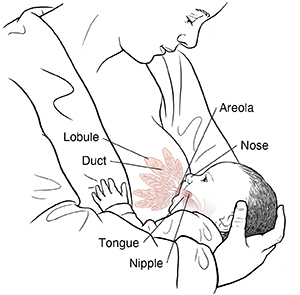Breastfeeding can seem mysterious at first. What’s going on inside the breast? Where does the milk come from? Can the baby breathe OK? In fact, mothers and babies are naturally designed for breastfeeding. The picture below shows how you and your baby work together during breastfeeding.
The right milk for the right time
As your baby grows, their needs change. And your body’s milk changes to suit those needs. You make 3 kinds of milk for your baby:
-
Colostrum is the first milk. It is thick and yellowish. Many people call it liquid gold. It provides all of the nutrients that your baby needs in the first days. It may not look like much, but it's all your baby needs during this time.
-
Transitional milk comes in 2 to 5 days after birth. It can look creamy, white, or yellow.
-
Mature milk begins in the second or third week after birth. It looks thinner or more watery. It can have a bluish tint. Levels of protein, fat, and antibodies in mature milk change as your baby’s needs change.
Lobules are structures that make and store milk.
Ducts are tubes that carry the milk to the nipple.
The baby’s nose is flat. This allows easy breathing while breastfeeding.
The nipple has many small openings where milk comes out.
The areola provides oils to clean the nipple and help baby latch. During feeding, as much of the areola as possible should be in the baby’s mouth. This helps the baby get milk out of your breast. It's also more comfortable than if the baby sucks on the nipple alone.
The tongue helps the baby breastfeed. You might even see the tip of it sticking out under the nipple while your baby nurses!
Featured in


